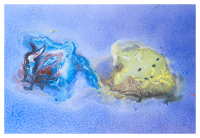Speaker
Akihiro Shibata
(High Energy Accelerator Research Organization (KEK))
Description
We have pointed out that the SU(3) Yang-Mills theory has a new way of reformulation
using new field variables (minimal option), in addition to the conventional option
adopted by Cho, Faddeev and Niemi (maximal option). The reformulation enables us to change the original non-Abelian gauge field into the new field variables such that one of them called the restricted field gives the dominant contribution to quark confinement in the gauge-independent way. In the minimal option, especially, the restricted field is non-Abelian U(2) and involves the non-Abelian magnetic monopole. This should be compared with the maximal option: the restricted field is Abelian U(1) x U(1) and involves only the Abelian magnetic monopole, just like the Abelian projection.
In the preceding lattice conferences, we have accumulated the numerical evidences
for the non-Abelian magnetic-monopole dominance in addition to the restricted non-Abelian field dominance for quark confinement supporting the non-Abelian dual superconductivity using the minimal option for the SU(3) Yang-Mills theory.
In this talk, we focus on discriminating between two reformulations, i.e., maximal and minimal options of SU(3) Yang-Mills theory for quark confinement from the viewpoint of dual superconductivity. For this purpose, we measure the distribution of the chromoelectric flux connecting a quark and an antiquark and the induced magnetic-monopole current around the flux tube, etc.
Author
Akihiro Shibata
(High Energy Accelerator Research Organization (KEK))
Co-authors
Kei-Ichi Kondo
(Chiba University)
Seikou Kato
(Fukui National College of Technology)
Toru Shinohara
(Chiba University)
